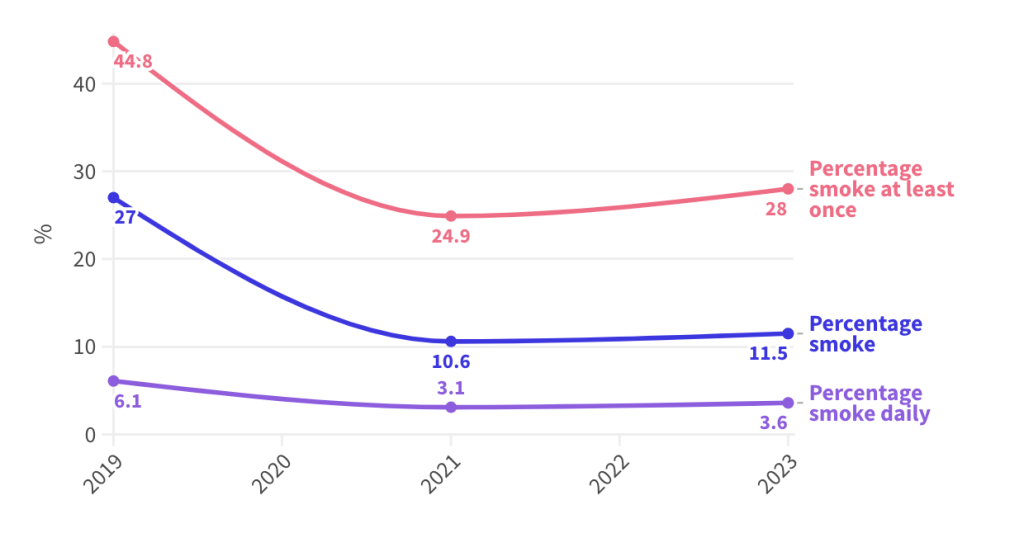While Connecticut has seen a steady decline in cigarette and vape sales overall, high school students’ use of tobacco grew slightly in the last year.
Data on e-cigarette sales reveals that the total volume of e-liquid sold has dropped since 2021, including that found in individual e-cigarette products. E-cigarette liquid sales experienced a more significant decline of approximately 25.4%. Sales have also decreased for items such as cartridges and pods.
Meanwhile, cigarette sales in Connecticut declined by approximately 20.1% from the second half of 2021 to the second half of 2024.
But tobacco and vape use among high school students slightly grew from 2022 to 2023. Approximately 19,800 high school students, or 12.7%, reported using any tobacco product in the past 30 days, according to the Connecticut Department of Public Health.
In 2023, 3.5% of male students and 2.4% of female students reported smoking cigarettes on at least one day in the 30 days prior to the survey. Cigarette use varied by grade, with 1.5% of ninth-graders smoking, 3.3% of 10th-graders, 2.5% of 11th-graders, and 4.9% of 12th-graders, according to the 2023 Connecticut School Health Survey.
Diahann Wilcox, a nurse practitioner at UConn Health, said that long-term combustible tobacco use can cause diseases.
“If a teen already has a lung condition, like asthma, it definitely will increase their risk of getting poor asthma control because it will irritate their airways,” she said. “And then the other thing too, like the risk for infectious diseases. When we smoke combustible tobacco, we do have a higher risk of bronchitis.”
Similarly, electronic vapor product use among high school students grew. In 2023, 9.3% of male students and 13.5% of female students reported using e-cigarettes or similar products. Usage also increased with grade level, with 6.8% of ninth-graders, 12.2% of 10th-graders, 12.4% of 11th-graders and 15.1% of 12th-graders reporting e-cigarette use.
“We don’t know everything when it comes to vaping nicotine products, and what kind of long term consequences are, but they [teenagers] are becoming highly addicted to the high levels of nicotine that are in these products,” Wilcox said. “It leads to use of other substances they take into their body, like cannabis.”
In 2023, 49.2% of high school students attempted to quit using all forms of tobacco, including cigarettes, cigars, e-cigarettes, shisha or hookah, and smokeless tobacco, within the past 12 months. This is about roughly 14,200 students, according to the Connecticut Department of Public Health.
Oct. 1 marked the five-year anniversary of Connecticut’s decision to raise the legal age for tobacco product purchases from 18 to 21, a policy implemented months before the federal government followed suit. The legislation aimed to protect youth by preventing individuals 18 and older, who still interact with underage peers in school settings, from supplying them with tobacco products. This policy was designed to reduce youth access and improve public health.
Despite this, Connecticut received an “F” grade from the American Lung Association for not investing enough money in programs that prevent and reduce tobacco use. Connecticut has no specific restrictions to limit or prohibit the sale of flavored tobacco products, which are the most attractive to teenagers.
“One of the things you’ll find is that kids, teens, will vape flavored vaping products,” Wilcox said. “And even though they’re not supposed to get them, they get them.”

